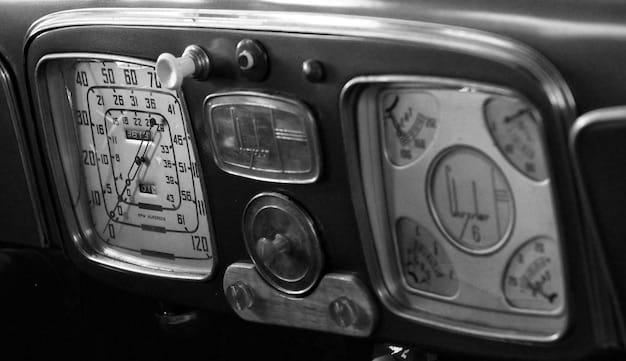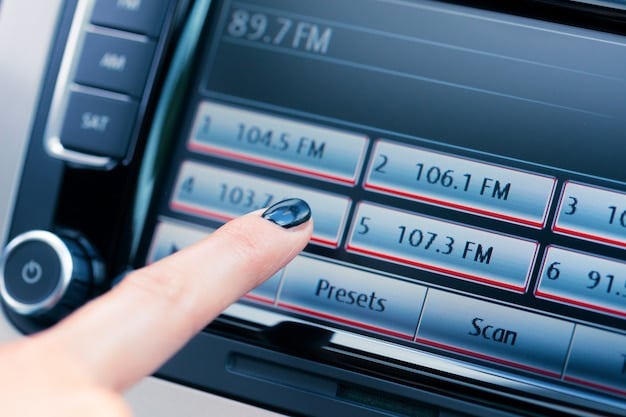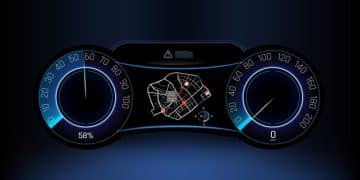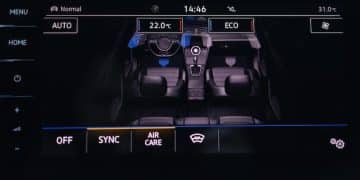The Evolution of Car Audio: From AM to High-Definition Sound

The evolution of car audio systems has transformed the driving experience, progressing from basic AM radios to sophisticated high-definition sound systems, incorporating features like Bluetooth connectivity, advanced speakers, and smartphone integration.
The journey of in-car entertainment has come a long way. What started with simple AM radios has evolved into a world of high-definition sound, smartphone integration, and immersive audio experiences. Let’s explore the evolution of car audio systems: from AM radios to high-definition sound, tracing its fascinating path and highlighting the key milestones along the way.
The Dawn of Car Audio: The AM Radio Era
In the early days of car audio, the AM radio reigned supreme. It was a simple, yet revolutionary, addition to the automobile, providing drivers and passengers with access to news, music, and entertainment while on the road.
The First Car Radios
The first commercially available car radios appeared in the 1930s. These were bulky, expensive devices that required significant modifications to the vehicle’s electrical system.
- Early car radios used vacuum tubes, which were prone to failure and consumed a lot of power.
- These radios were often installed under the dashboard or even in the trunk, with remote controls mounted on the steering column.
- Tuning was a manual process, requiring drivers to adjust knobs to find the desired frequency.
Despite their limitations, AM radios quickly became a popular accessory, transforming the driving experience and paving the way for future advancements in in-car entertainment. The accessibility of real-time information and music was a game-changer, making long drives more enjoyable and connected.

The Rise of FM Radio and Stereo Sound
The introduction of FM radio and stereo sound marked a significant leap forward in car audio technology. FM radio offered superior sound quality and less static compared to AM, while stereo sound created a more immersive listening experience.
FM Radio Takes Center Stage
While FM radio was invented in the 1930s, it didn’t become widely available in cars until the 1960s. The improved sound quality made FM a popular choice for music enthusiasts.
The transition to FM radio in cars wasn’t immediate, but as technology improved and FM stations became more prevalent, its adoption grew steadily. Car manufacturers began including FM tuners in their radio models, and aftermarket solutions allowed drivers to upgrade their existing AM radios.
The Advent of Stereo Sound
The introduction of stereo sound in car audio systems further enhanced the listening experience. Stereo systems used two or more speakers to create a wider soundstage and more realistic audio reproduction.
- Early stereo systems often consisted of two speakers mounted in the front of the car, but later systems added speakers in the rear for a more immersive sound.
- The development of more powerful amplifiers allowed for louder and clearer sound reproduction.
- Cassette players and 8-track players also contributed to the rise of stereo sound, as they allowed drivers to play pre-recorded music in their cars.
FM radio and stereo sound revolutionized car audio, providing drivers with a more enjoyable and engaging listening experience. This era set the stage for further innovations, including the introduction of cassette players and CD players.
Cassette Tapes and the 8-Track Era
The introduction of cassette tapes and 8-track players brought portable music to the car, giving drivers more control over their listening experience. These formats allowed drivers to play their own music mixes and albums while on the road.
The Rise and Fall of 8-Track Tapes
8-track tapes were popular in the 1960s and 1970s, offering a convenient way to play music in the car. However, they were prone to skipping and offered limited sound quality.
Despite their drawbacks, 8-track players were a common feature in many cars during this era. They were relatively inexpensive and easy to use, making them a popular choice for music lovers on the go.
The Cassette Tape Revolution
Cassette tapes offered a more compact and versatile alternative to 8-track tapes. They provided better sound quality and the ability to record music from the radio or other sources.
- Cassette players quickly became a standard feature in cars, replacing 8-track players in popularity.
- The ability to create custom mixtapes allowed drivers to personalize their in-car listening experience.
- The development of noise reduction technologies, such as Dolby, further improved the sound quality of cassette tapes.
Cassette tapes transformed car audio, giving drivers more control over their music selection and creating a more personalized listening experience. This era also saw the rise of aftermarket car audio systems, as drivers sought to upgrade their factory-installed stereos with more powerful amplifiers and speakers.
The Digital Revolution: CD Players and Beyond
The introduction of CD players marked the beginning of the digital revolution in car audio. CDs offered superior sound quality and durability compared to cassette tapes, and they quickly became the preferred format for music lovers.

The Arrival of CD Players
CD players first appeared in cars in the mid-1980s. They offered a significant improvement in sound quality compared to cassette tapes, with a wider dynamic range and lower noise levels.
The integration of CD players into car audio systems required significant changes to the design of dashboards and consoles. CD players were larger and more complex than cassette players, and they required more sophisticated electronic components. However, the improved sound quality and durability of CDs made them a worthwhile investment for many drivers.
The Transition to Digital Audio
The advent of CD players paved the way for further advancements in digital audio technology. MP3 players, iPods, and other portable music devices allowed drivers to store and play thousands of songs in their cars.
- The development of digital signal processing (DSP) technology further improved the sound quality of car audio systems.
- DSP chips allowed for more precise control over equalization, time alignment, and other audio parameters.
- The integration of navigation systems and other advanced features into car audio head units transformed the driving experience.
The digital revolution has transformed car audio, providing drivers with access to a vast library of music and a wide range of advanced features. This era has also seen the rise of streaming music services, which have further expanded the possibilities for in-car entertainment.
The Era of Connectivity: Bluetooth and Smartphone Integration
The integration of Bluetooth and smartphone connectivity has revolutionized car audio, allowing drivers to seamlessly connect their mobile devices to their car’s audio system. This has opened up a world of possibilities for in-car entertainment, including streaming music, hands-free calling, and access to navigation apps.
Bluetooth Connectivity
Bluetooth technology allows drivers to wirelessly connect their smartphones to their car’s audio system. This enables hands-free calling, streaming music, and access to other smartphone features.
The integration of Bluetooth into car audio systems has made driving safer and more convenient. Drivers can now make and receive calls without taking their hands off the wheel, and they can easily stream their favorite music from their smartphones.
Smartphone Integration
Smartphone integration platforms, such as Apple CarPlay and Android Auto, provide a seamless and intuitive way to access smartphone apps and features through the car’s infotainment system.
- These platforms allow drivers to use voice commands to control music playback, navigation, and other functions.
- They also provide access to a wide range of apps, including streaming music services, podcasts, and audiobooks.
- Smartphone integration has transformed car audio, turning the car into a mobile entertainment hub.
The era of connectivity has made car audio more convenient, versatile, and integrated than ever before. Drivers can now enjoy a seamless and personalized listening experience, with access to a vast library of music and a wide range of advanced features.
High-Definition Audio and the Future of Car Audio
The pursuit of high-definition audio is driving the future of car audio. New technologies and formats are emerging that promise to deliver an even more immersive and engaging listening experience. From advanced speaker systems to lossless audio formats, the future of car audio is bright.
Advanced Speaker Systems
Car audio manufacturers are developing increasingly sophisticated speaker systems that deliver more accurate and detailed sound reproduction. These systems often incorporate multiple speakers, advanced materials, and precision tuning to create a wider soundstage and more immersive listening experience.
The integration of these advanced speakers requires careful consideration of the car’s interior design and acoustics. Manufacturers are working to optimize speaker placement and sound damping materials to minimize unwanted reflections and resonances.
Lossless Audio Formats
Lossless audio formats, such as FLAC and WAV, offer higher fidelity thancompressed formats like MP3. These formats preserve all of the original audio data, resulting in a more accurate and detailed sound reproduction.
- The increasing availability of high-resolution audio streaming services is driving the demand for lossless audio playback in cars.
- Car audio systems are being designed with the ability to decode and play lossless audio files, providing drivers with access to the highest quality audio available.
The future of car audio is focused on delivering an increasingly immersive and engaging listening experience. As technology continues to evolve, we can expect to see even more sophisticated and innovative car audio systems that transform the way we listen to music on the road. The evolution of car audio systems: from AM radios to high-definition sound, promises a future where the driving experience is enhanced by pristine, crystal-clear audio.
| Key Point | Brief Description |
|---|---|
| 📻 AM Radios | The start of car audio, offering basic news and music access. |
| 🎶 FM & Stereo | Improved sound quality and a more immersive listening experience. |
| 🎵 Cassette Tapes | Portable music with customizable mixtapes. |
| 💽 CD Players | Digital sound quality and increased durability. |
Frequently Asked Questions
▼
Car radios first became commercially available in the 1930s, though they were expensive and required significant modifications to a car’s electrical system.
▼
FM radio provided superior sound quality and less static compared to AM radio, making it a preferred choice for music enthusiasts.
▼
Cassette tapes allowed drivers to play their own music mixes and albums, offering a more personalized listening experience than AM/FM radio alone.
▼
CD players offered superior sound quality and durability compared to cassette tapes, making them a popular choice for music lovers.
▼
Bluetooth connectivity has revolutionized car audio by allowing drivers to wirelessly connect their smartphones, enabling hands-free calling and music streaming.
Conclusion
From the crackling sounds of early AM radios to the crystal-clear audio of modern high-definition systems, the evolution of car audio systems: from AM radios to high-definition sound has greatly enhanced our driving experiences. As technology continues to advance, the future promises even more immersive and personalized audio experiences on the road.





